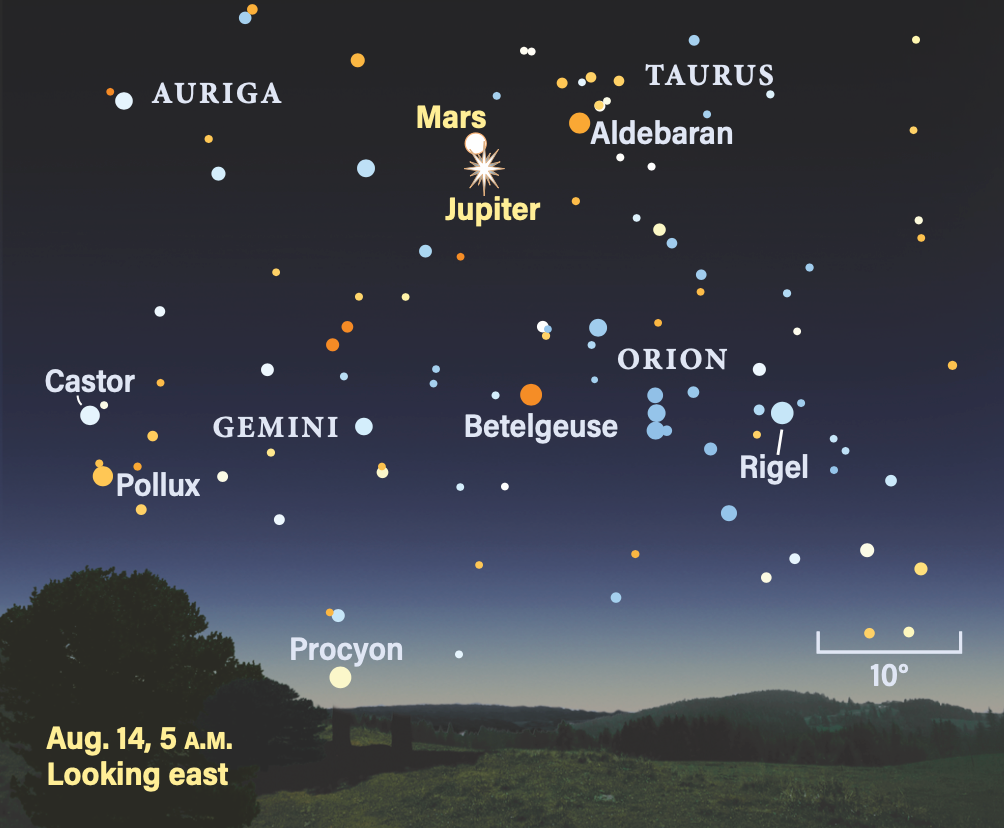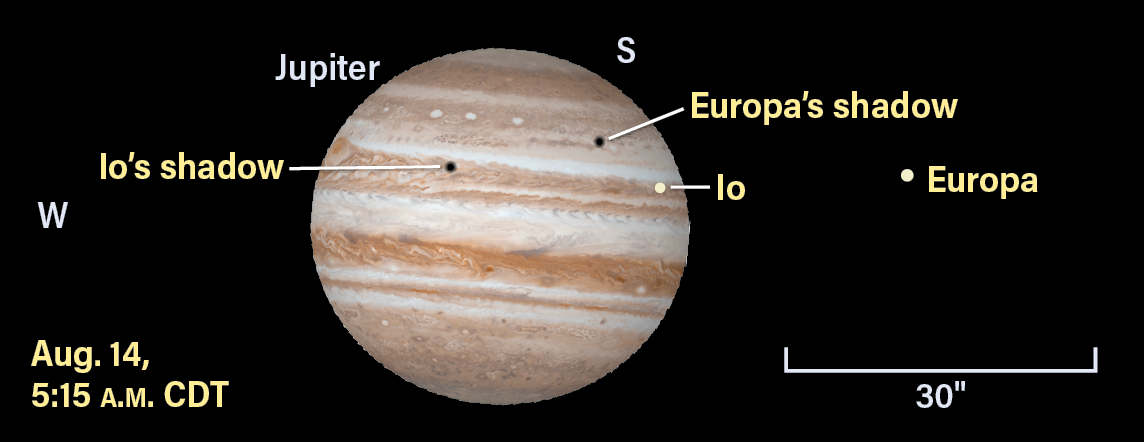
The peak of the Perseid meteor shower has been grabbing headlines this week, but there’s another upcoming event visible tomorrow morning you won’t want to miss: the close conjunction of Mars and Jupiter. In the pre-dawn sky of August 14, the two planets will blaze brightly in the constellation Taurus and stand just 0.3° apart, less than the width of the Full Moon in the sky.
The sight will be visible in the early-morning hours; the planets rise together in the east around 1 A.M. local daylight time and reach 45° in altitude in the hour before dawn. They appear in eastern Taurus, to the lower left of the bright red giant star Aldebaran, which marks the Bull’s eye. They are also below and to the left of the famous Pleiades open cluster (M45).
The planets are bright — Jupiter shines at magnitude –2.2, while Mars is magnitude 0.8. You won’t need a telescope or even binoculars to find them, shining between the horns of the Bull. However, you will be able to zoom in on the pair with binoculars or a telescope if you wish — and particularly if you have the latter available, it’s worth a look. Both planets will appear together within the same low-power field of view even of a telescope, a stunning and unusual sight.
Jupiter
Through a scope, Jupiter’s disk stretches nearly 37″, showing off incredible detail. Instruments will show several alternating light and dark cloud bands, while the Great Red Spot should be visible particularly for those in the eastern half of the U.S. as the planet is rising. The gas giant is flanked by its four largest moons: Io, Europa, Callisto, and Ganymede. Early in the morning, Callisto sits alone far to the planet’s west, with Io closest to the eastern limb, followed closely by Europa, while Ganymede is farther east.
In addition to the conjunction with Mars, there’s a lot going on around Jupiter this morning. Around 4:40 A.M. EDT, a small dark spot will appear on the cloud tops of the eastern limb, moving from east to west — this is Io’s shadow, with the moon following as it transits the planet starting around 5:55 A.M. EDT. Before that can happen, however, the dark blot of Europa’s shadow will also appear, just after 5:30 A.M. EDT. Io’s shadow slips off the western limb around 5:52 A.M. CDT (after sunrise on the East Coast), followed by Europa’s shadow around 6 A.M. MDT (after sunrise in the Midwest) and Io itself about 5 minutes later. At the same time, Europa is just crossing in front of the planet from the east to begin its own transit, which observers on the West Coast can follow through sunrise.

Mars
Meanwhile, Mars stands to Jupiter’s north; the Red Planet will cross due north of Jupiter in the sky at 1 P.M. EDT, during the daylight hours in the U.S. If you watch for several hours this morning, you may be able to catch the subtle eastward motion of the planet as it moves in from Jupiter’s northwest. Although much closer to Earth than Jupiter — Mars now stands 1.5 astronomical units (AU) away, as opposed to Jupiter’s distance of 5.4 AU from Earth — it is also physically much smaller than Jupiter, and its disk accordingly spans just 6″. (One AU is the average Earth-Sun distance.) If you were to place Mars and Jupiter side by side, Jupiter would stretch more than 22 times as wide as Mars, which itself is only roughly half as wide as Earth.
Because Mars is so small, it’s difficult to see surface features without specialized equipment and techniques. Those with large scopes and video-capture capabilities, however, may be able to see the dark smudge of the volcano Syrtis Major on the tiny martian disk.
Bonus planet: Uranus
Taurus is currently home to three planets — the distant ice giant Uranus is in western Taurus, about 5° south-southeast of the Pleiades. Because it glows a faint magnitude 5.8, you will need binoculars or a telescope to spot it. The disk of Uranus is just under 4″ across, thanks to its great distance (nearly 20 times the distance of Earth from the Sun), and won’t show any detail. It will instead look like a small, “flat” gray star when compared to the background stars in the region.
A view you won’t want to miss
Jupiter is currently approaching its best apparition in the Northern Hemisphere in a decade, and the chance to spot it close to Mars is one you won’t get again until 2026. Plus, with the Perseids winding down and no Moon in the morning sky, you might just catch a higher-than-average number of shooting stars streaking overhead while you’re observing.
It will be a beautiful naked-eye scene that will reward early risers — make sure to set your alarm!
Wednesday, August 14
Sunrise: 6:11 A.M.
Sunset: 7:57 P.M.
Moonrise: 4:20 P.M.
Moonset: 12:18 A.M.
Moon Phase: Waxing gibbous (70%)
*Times for sunrise, sunset, moonrise, and moonset are given in local time from 40° N 90° W. The Moon’s illumination is given at 12 P.M. local time from the same location.









